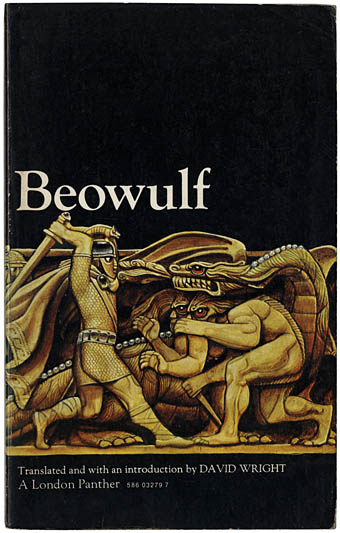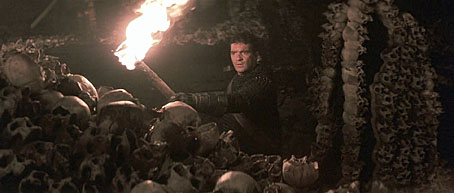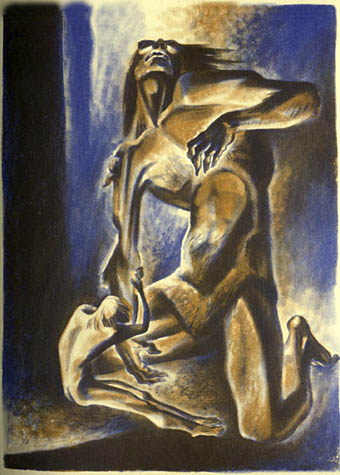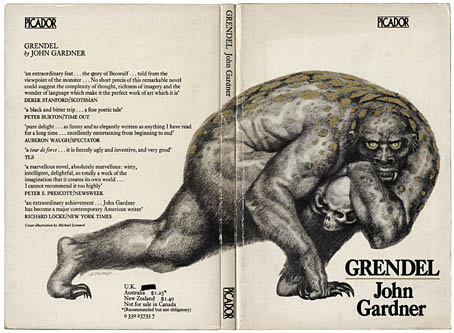Beowulf wrestles with Grendel, Lynd Ward (1939).
There’s nothing new in pointing out Hollywood’s crimes against literature, the film business has been screwing up book adaptation since the earliest days of silent cinema. But sometimes the wound is so grievous you can’t help but speak out, in this case against Roger Avary’s Beowulf which is released next month. This is another CGI-heavy confection along the lines Polar Express, with the actors being given digital bodies via motion-capture, and it’s something I’d probably have ignored until I saw this picture of Grendel, the story’s principal monster. Beowulf is one of the earliest surviving Anglo-Saxon poems and Grendel, the bloodthirsty creature which Beowulf battles, is one of the ur-fiends of English literature, along with his equally monstrous, lake-dwelling mother and the dragon which fatally wounds the hero. The trio give us a peek back into the dark imagination from a time before recorded history and Grendel especially has always had something raw and primal about its character. So when you see a beast with such a history portrayed as little more than a diseased muppet you wonder what’s going on. Are the creators inept? Ignorant? Were studio restrictions at work? How does an industry with the talent to give splendid life to the trolls and Balrog of Lord of the Rings, or Davy Jones and crew in Pirates of the Caribbean, screw up so badly?

Illustration by Michael Leonard (1970).
The grim demon was called Grendel, a notorious ranger of the borderlands, who inhabited the fastnesses of moors and fens. This unhappy being had long lived in the land of monsters, because God had damned him along with the children of Cain. For the eternal Lord avenged the killing of Abel. He took no delight in that feud, but banished Cain from humanity because of his crime. From Cain were hatched all evil progenies: ogres, hobgoblins, and monsters, not to mention the giants who fought so long against God?for which they suffered due retribution.
Grendel is described thus in the David Wright translation, my first contact with the dread beast when we read the Panther edition at school in the early Seventies. I’d guess it was that book which also introduced Neil Gaiman (co-writer of the new film) to the story, since we’re both about the same age. The book caught me at the right time since I was already besotted with Norse mythology via Roger Lancelyn Green’s Myths and Legends of the Norsemen and I loved the way that Michael Leonard’s stylised cover illustration (which wraps around the book) hints at much but still allows room for the imagination. Beowulf marks the point when the old myths of monsters and dragons become subject to an increasingly obtrusive Christian morality. The rationale for Grendel being one of the “sons of Cain” has always seemed laboured and unconvincing, however, as though the new religion had been written over something far older and far darker. It’s never quite clear what Grendel and his mother are, which is a great part of their attraction; as with HP Lovecraft’s monstrosities, our imagination rushes to fill the void left by the sketched outline.
Illustration by Michael Leonard (1973).
Having said that, there’s no doubt as to Grendel’s nature in this tremendous representation (highlighted with gold ink), also by Michael Leonard and a great example of Picador book design at its height. It’s a shame that Gardner’s book, which tells the story of Beowulf from the viewpoint of the monster, fails to live up to the promise of the illustration, which does justice to a creature described as killing fifteen men while they sleep. Gardner’s narrative is more a satire than a horror tale with the creature in a perpetual state of bemusement at the antics of the men he preys upon. The book has its supporters but I found the jokey tone and anachronisms increasingly annoying. Jeff Sypeck points out some flaws in Gardner’s approach here.
As an aside, I didn’t realise Michael Leonard was a gay artist until I did a search to see what he might be doing now. In common with many illustrators, he’s left the field to pursue more personal work, in this case hyper-real still lifes and finely-rendered figure studies like the one below.
Against the Glass (2001).
I haven’t seen the science fiction film version of Beowulf from 1999 or Beowulf and Grendel from 2005, and going by the silly caveman/hobo look of Grendel in the latter I’d say that was probably a good thing. It’s possible, if you want to stretch the point, to see HR Giger’s creature in Alien as another incarnation of Grendel. Why? Because of the moment when the crew of the ship realise they have a killer on board and Ash calls it “Kane’s son”, Kane being the unfortunate crew member who gives birth to the beast.
The most interesting adaptation to date is The Thirteenth Warrior, a flawed film but one that holds together despite its troubled production. This was based on Michael Crichton’s 1976 novel Eaters of the Dead which takes the demystification route but in a consistent fashion, with Grendel becoming the Wendol, a tribe of head-hunting evolutionary throwbacks who prey upon an isolated village. Despite explaining away the story’s supernatural qualities, the film has its own chills, especially when the “fire snake” appears (whose true nature I won’t spoil here). The most surprising aspect of the film now is the role played by Antonio Banderas, the thirteenth warrior of the title and also a Muslim hero, something that wouldn’t be allowed in a big-budget Hollywood film today.

At home with the Wendol: The Thirteenth Warrior (1999).
Antonio Banderas came to prominence with his eye candy roles for Pedro Almodovar and it’s perhaps fitting that a gay artist should have illustrated Beowulf at least once, muscle-bound epics having what you might call a dual appeal. Bearing that in mind, there’s this curious statement given by Roger Avary to Entertainment Weekly about the new film, which sees portly Ray Winstone as the hero, slimmed down to a gleaming, six-packed action figure:
When I wrote it, I envisaged the character of Den in the Heavy Metal comic. Den was a character by Richard Corben, who was easily one of my favorite artists. [Den] was this muscular guy with a gigantic schlong. He would always go into battle and beat the hell out of people, totally in the buff. He never wore clothes. That kind of stuck with me. I love it when somebody takes something like a fight?or really any event?and twists it to the point where you’re naked doing it. Also, there was a proud tradition of berserkers going into battle naked. It just shows how fearless you are. I don’t know about you, but if someone came at me, like, ”Aaaaargh!” naked, I’d be, ”Whoa!” Had we done it [like] Richard Corben’s Den, the MPAA would have had huge, huge problems. As it is, I think the movie is going to have to achieve a more tempered rating. I don’t think that we’re going to be [seeing] Beowulf’s gigantic, you know, baby’s-arm-holding-an-apple-sized schlong onscreen. However, because this is performance-capture, it’s not inconceivable that, at some point down the road, they simply re-render, widen-out shots, move things out of the way and put together a hard-R or NC-17 version of the movie.
Er, okay Roger, do you have something you want to tell us? As with the egregious Frank Miller and 300, which managed the feat of being homophobic and homoerotic simultaneously, there seem to be some unexplored issues at work here. Well I’m afraid even the addition of CGI schlongs is unlikely to make me want to watch Avary’s film (sorry Neil). The Thirteenth Warrior is grittier and closer to the spirit of the original tale despite its radical reworking and I’ll take the real Antonio over a plastic Ray Winstone any day.
The Lynd Ward picture at the top of this page comes from Beowulf: A New Verse Translation for Fireside and Classroom, Heritage Press, 1939. I looked at Ward’s God’s Man back in August and Eddie Campbell noted recently that his work is featured in a new collection. You can see the rest of Ward’s marvellous Beowulf illustrations here.
Elsewhere on { feuilleton }
• The gay artists archive
• The illustrators archive
Previously on { feuilleton }
• Men with snakes
• Gods’ Man by Lynd Ward
• Davy Jones




Thank you John.
I am glad to finally see in writing that there are no official theory about what type of creatures are supposed to be Grendel and his mother.
The question has been annoying me ever since I read the book and, apart from the fact that both creatures seemed very different (for being blood relatives), I could not find an answer to my query.
I asked all my native English friends because they would have studied the book at school and I thought that if English litterature studies are anything like the French ones, the book would have been read, quartered, écorché, autopsied, reverse engineered and analysed ad nauseam. So I thought an answer would be coming.
It did in a way: I got plenty of embarassed silence back.
Strange when you think there are loads of official and unofficial portraits of what Tolkien’s (or even Lovecraft’s) creatures look like.
As for the new movie, I have seen the various trailers and must say that I have difficulties to reconcile the bits seen with actual parts of the book. The adaptation seems to have completely rewritten the story, reinventing it almost, keeping just a few markers here and there. Creative, sure, and maybe it WAS needed for the story to come out as an attractive movie but where’s the book ?
On the one hand, I know that judging a film on its trailers is not fair at all as they usually give a distorted vision of the story (and the invisible but largely suggested shlong part fits in particularly well in that distorsion).
On the other, I can’t say I am even remotely tempted to rush out to see the movie.
On another unrelated subject, I suppose you will have seen this video and of all the violent controversy it is causing on YouTube…
Thanks Nathalie, I’d not thought about Beowulf as it might seem to people in other countries. Part of the confusion stems from its origin as a saga which would have been sung at one time. All these works are full of elaborate metaphors (“dragon’s bed” meaning gold, for instance) which the original audience would have understood but which we need explaining. Borges writes a bit about this. Then there’s the difference in translation from one version to another which adds to the confusion.
But Grendel is very undefined despite having a proper name when he could easily have been a nameless ogre or something. It’s that which makes me suspect he was something far older. Grendel’s mother is described as a water-hag of which there are many varieties–kelpies and things–in the northern countries. Grendel seems to be part kelpie and part monstrous human. John Gardner’s novel has the monster ruminating on its possible relationship to humans. I’ve not read Tolkien’s famous essay on Beowulf but Lord of the Rings owes a lot to the poem, especially the Riders of Rohan, even down to sharing a character named Eomer. And it’s true, one shouldn’t judge a film merely from the trailer but it fares badly beside The Thirteenth Warrior which I watched again recently.
I saw that HPL video just yesterday. Funny that people have to argue about it being a fake or not, if there was any film of Lovecraft it would have been common knowledge by now. As it happens, HPL mentions Beowulf in passing in his essay on supernatural fiction. And oddly enough, Michael Crichton apparently credits the Necronomicon in the bibliography for Eaters of the Dead.
Excellent piece John.
Reading through it just now did bring to mind an interesting spin on Grendel though. Beowulf is largely a work of norse myth… and yet here is the “Son of Cain”, a born outsider, killing off the local warriors?
Interesting that a beast of Christian myth would appear and start killing norsemen given the eventual capitulation of the Norse to Christianity.
Was God softening them up? Was Grendel seeking redemption?
Ah… this is the problem when you start messing with your mythologies while translating. It throws open a lot of interesting questions.
Thanks Jonathan,
Given the nature of folk tradition, I’d imagine Beowulf is older than the surviving text yet it’s the Christian take on the story which comes down to us. You get the sense of people struggling to make sense of their older stories through a new and competing myth so it’s not surprising if it seems incoherent or inconsistent.
You do get some explanation along the lines of Grendel being part of the race of creatures who rebelled against God and which have preyed on God’s children ever since. But it’s never convinced this reader! As I said above, Grendel’s mother has a lot of cousins in northern folk tales but you won’t find any “water-hags” in the Bible.
“The Thirteenth Warrior is grittier and closer to the spirit of the original tale despite its radical reworking and I?ll take the real Antonio over a plastic Ray Winstone any day.”
Not sure how you can say that with such casual assurance without having seen the film, John.
I saw it yesterday for the first time, and it’s a lot more like Beowulf than The 13th Warrior is. And Crispin Glover’s performance as Grendel is remarkable.
Hi Neil,
Yeah, it is presumptive as I mentioned to Nathalie above. The “gritty” thing refers to real grit (and all the dirt and rain in 13th W) as opposed to CGI. Good luck with the film in any case.
I saw the CGI version of “Beowulf” in the movies when it came out. I agree that the rendering of Grendel was hidieous and so ridiculous that it spoiled that segment. I also found the hide and seek with Beowulf’s “scepter” reminiscent of the antics in Austin Powers, man of Mystery. For some reason the women in the film see flatly rendered while the old men almost hyper-real. However the best parts including the stunning gold dragon beautiful rendered and conceived andthe eye candy, Angela Jolie dripping gold, did not hurt.
I love the movie the “13th Warrior.” I think I seen it 4 or 5 times. Who ever cast the movie could not have selected better actors. Even though they all tower over Antonio, I think he did some of his best work in this picture. My one question is why they chose to not have Neanderthals [as the book indicates] the curse the village is facing. Recent archeological evidence confirms that Neanderthals and Modern man overlapped for several thousand years. As is alwasy the case the studio should have just filmed the movie based completely Michael Crichton’s book with no changes. He is such a meticulous researcher, I am sure the details in his timeline are perfect.
The drawing by Michael Leonard is truly inspiring… Thank you for sharing
after reading everything and watching most i feel in my heart of hearts that grendel and mother were neanderthal outcasts turned to murder and raiding for survival in a world where modern homo sapiens is either wiping out the neanderthals or breeding with them.
surely in the more isolated areas small pockets of ‘different’ humans would stand out more…
the facts of them living on or in water also is disturbing if you examine how adulterors and criminals were disposed of on the edges of communities they were staked out in deep pools which were a place where the soul would be caught forever between the 2 worlds a place where grendel existed….?
so for me grendel had to exist and if he did he would have to be a bloody big neanderthal outcast…..
just a thought?
I read John Gardner’s Grendel first, and later read a translation of Beowulf by Seamus Heanley I believe. Any ways the CGI Grendel really bugged me in the trailers, but I gave the movie a chance any ways and while I still do not like what they did with the story and especially with the appearance of Grendel and even his mother, the movie is still enjoyable if you go into it with an open mind. I think you can see that it doesn’t take itself seriously and so it becomes a bit of a comedy.
I would really really love a true to the original story film adaption of Beowulf though. Gritty with Grendel as an actual scarey beast instead of just some burly man or mutant or whatever. I agree that The 13th Warrior is the closest thing we’ve gotten to it. It’s funny because I didn’t know the first time I saw it that it was based off Beowulf and yet I remember thinking “Wow this is just like Grendel” which I’d recently read.
I also don’t enjoy how in the majority of these Beowulf movies Grendel’s father is Hrothgar, and Grendel’s mother is a seductress. Perhaps I missed it when reading Beowulf, but I didn’t think that was even hinted at in the original story and yet the majority of these movies add it as a plot device. I want a monster Grendel with a monster of a mother.
Sorry for a bit of a winded rant, but I’ve got some strong views on it as it seems others here do too and felt like venting a bit to people who actually seem to care!
I have a question is Grendel Cain’s son or was just put in the same catorgory as Cain
Hi Kris. I think it’s intended more as a metaphor: Cain was a murderer; Grendel murders men, therefore Grendel is Cain’s “son”. Jorge Luis Borges talks about the sometimes complex metaphors you find in Norse and related poetry: he mentions blood being “sword-water”, gold is “the dragon’s bed”, etc. “Cain’s son” would appear to be a similar attempt to use metaphor which is given a Christian emphasis.